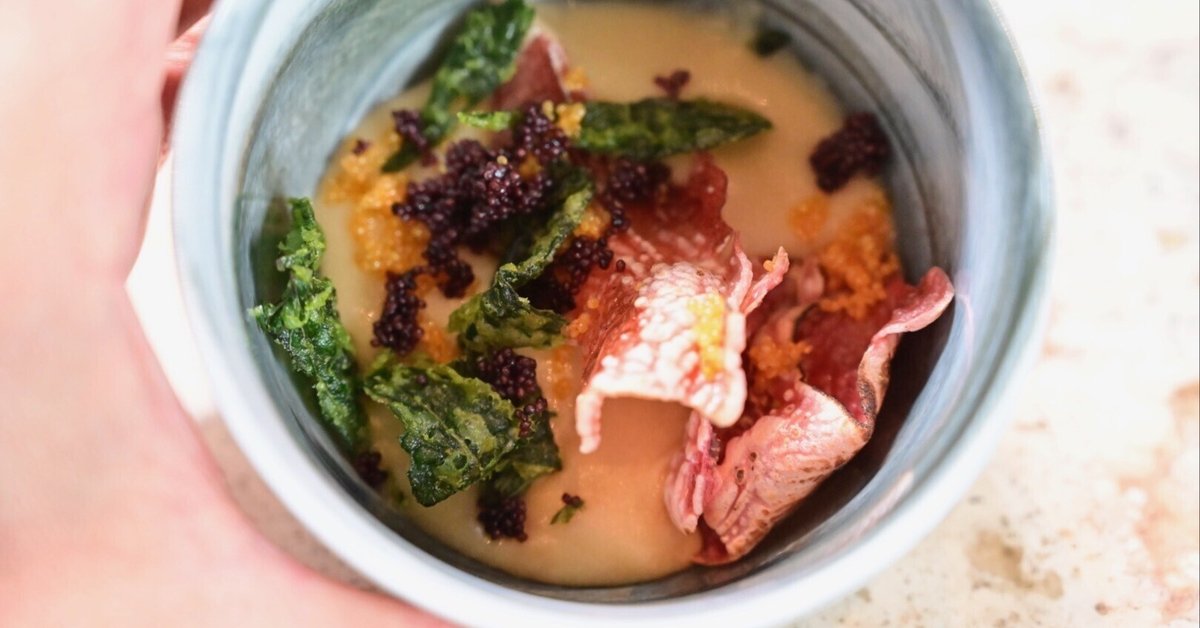
ペルー2:世界No.1レストラン「CENTRAL」母なる世界メニュー中編
昨年夏から岡山、富山、ソウル、ハンガリー、沖縄・コザ、スペイン・ガリシア、バスク、イスタンブル、中国・佛山、ベトナムと出張や旅が途切れなく続いた。更に年末には11冊目の著書『マージナル・フーディー・ツアー』が刊行となった。そのため前回の投稿から半年も間が空いてしまったが、ペルー・リマのレストラン「CENTRAL」の食べ歩き記事を再開しよう。同店は2023年のThe World's 50 Best Restaurants.comでNo.1に選ばれた、現在世界最高と目されるレストランである。
English follows Japanese.
2023年2月14日、僕は料理ユニット「ザ・ハーブズメン」のシャンカール・ノグチさん(インド・アメリカン商会)、水野仁輔さん(カレー料理家)と、三軒茶屋の人気インド料理店「シバカリーワラ」の山登伸介さんたちとセントラルを訪れた。そして、看板メニューである全12品の「標高メニュー」を更に進化させた全14品の「Mundo Matar(母なる世界)」メニューを注文した。ペルーを訪れたきっかけやここまでの流れは前回の記事をお読みいただきたい。

ペアリングドリンクは世界のワインコースをチョイス
「Mundo Matar(母なる世界)」メニューに合わせるペアリングドリンクのコースは3種類。一つ目はペルー産ワインとぶどうの蒸留酒ピスコ、その他、地元の発酵ドリンクを組み合わせた「ペルー産アルコールのコース(454ソル、当時のレートで15,890円)」、二つ目は「世界中から厳選されたワインのコース(424ソル、14,840円)」、そして三つ目が「ノンアルコールドリンクのコース(225ソル、7,875円)」。ワイン好きの僕はもちろん世界のワインのコースを選んだ。すると最初の一杯は母なる世界の旅路のスタートにふさわしいお酒、シャンパーニュが来た! ピノ・ノワール種を使ったブラン・ド・ノワール(黒ブドウを使ったスパークリングワイン)、しかもビオロジック(有機栽培)だ。美味いのは当然ながら、泡は気分が上がるねえ!
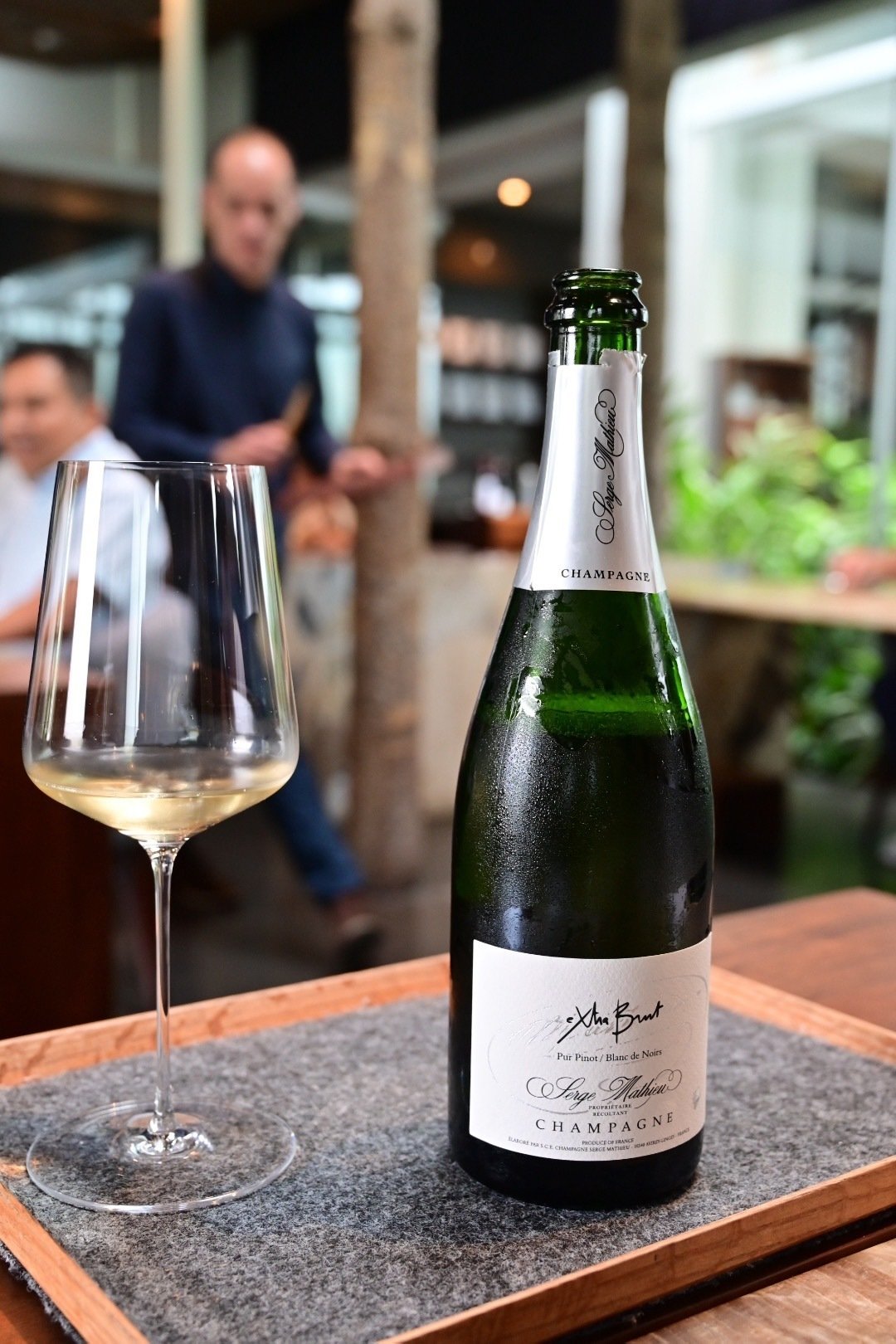
そんなシャンパーニュとともに届いた最初のアミューズ「黒い石:海抜マイナス10m アオサ、アサリ、烏賊」は小さな一口サイズの3品からなる。古い石板の上にのった1つ目は生の烏賊を乗せた団子。団子は乾燥させた烏賊の粉末とコーンフラワーを固めたものだろうか? 鮮やかな青緑色はアオサ海苔とのこと。口に入れると濃厚でフレッシュな烏賊の味と海苔の味が広がる。
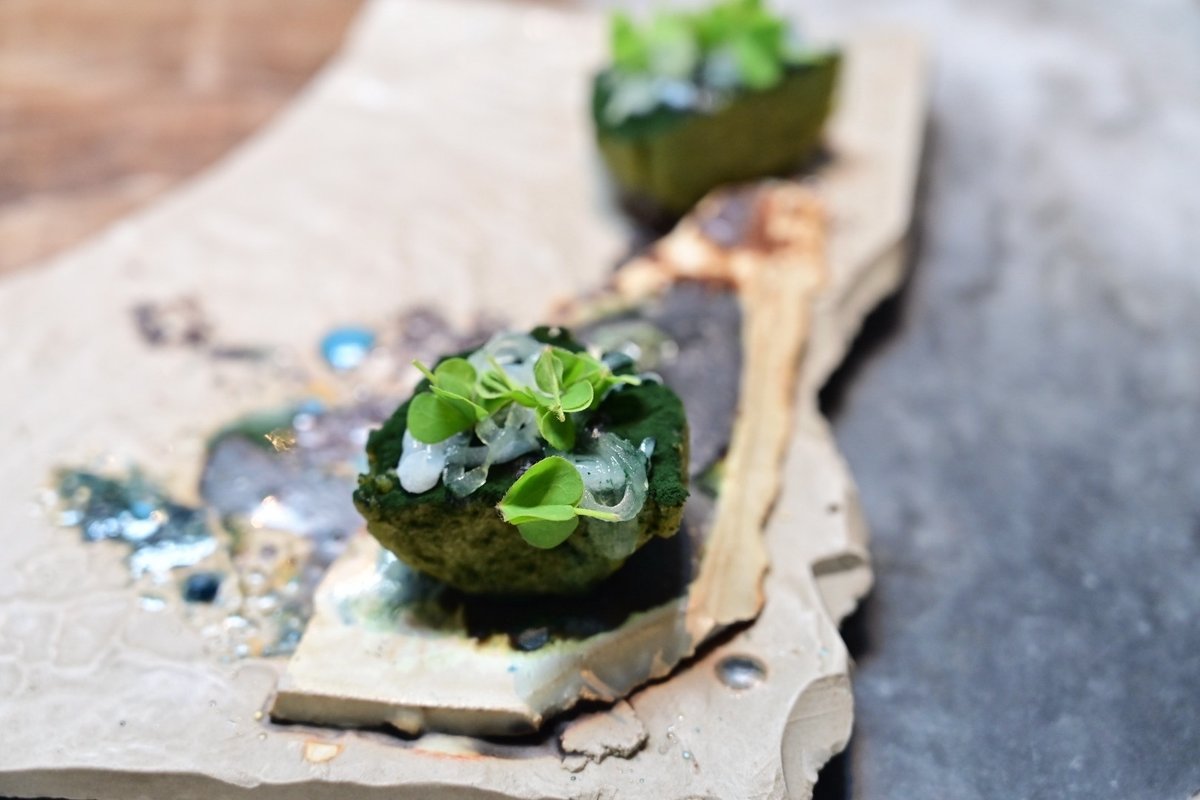
2つ目はコバルトブルーの茶碗に入ったコバルトブルーのクリーム。この鮮やかなブルーも海藻の色だそう。中には海藻とアサリのクリーム、磯の味にレモンやライムとは異なる何かの酸っぱさが乗っている。
3つ目は生のマテ貝の身が海の味がする泡に隠れている。やはり柑橘とは異なる酸味、更に緑色のハーブオイルと、黒い海苔のオイルが振りかけられている。美味い! 2つ目と3つ目は生のシーフードを酸味でマリネしているのだから、ペルーを代表する料理「セビーチェ」のバリエーションと言えるだろう。ちなみに烏賊もアサリもマテ貝も海抜マイナス10m、太平洋の浅瀬からの恵みである。
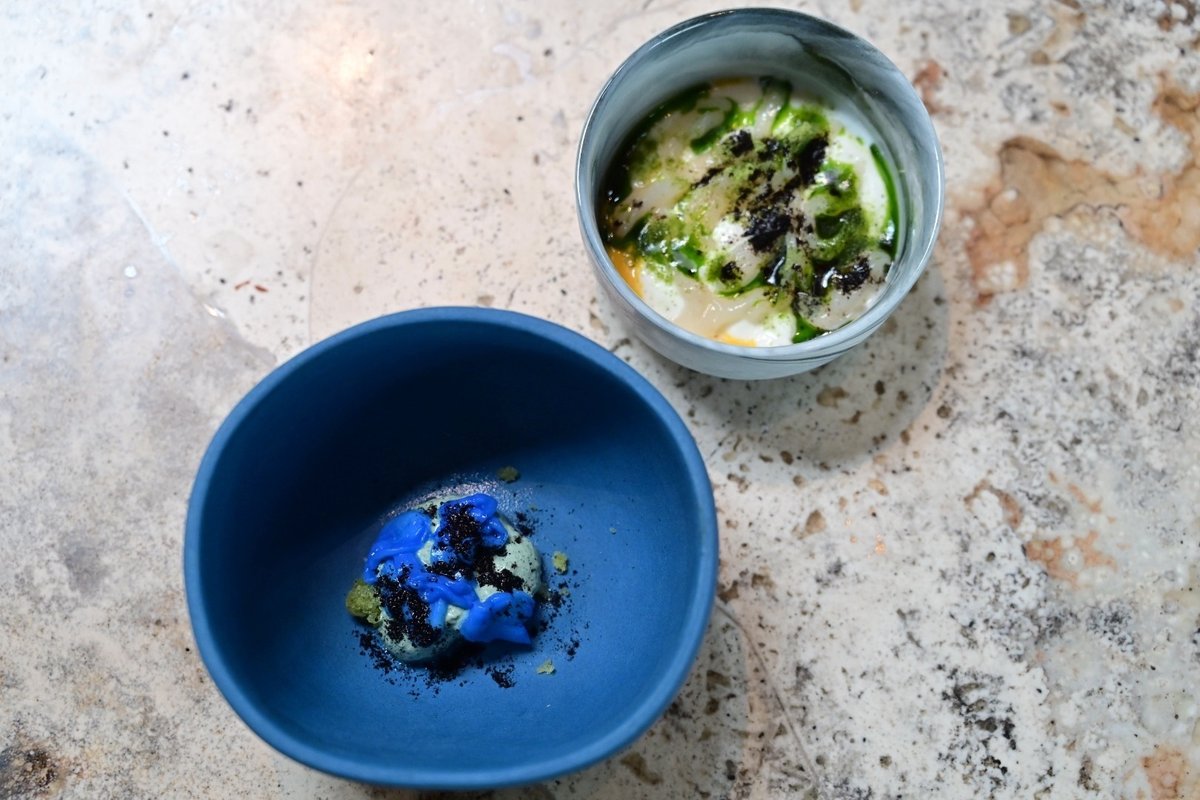
2杯目はスペイン北部リオハのビウラというブドウ品種の白ワイン。2011年とかなりのヴィンテージで、すばらしい樽香がする。

合わせる2皿目の料理は「乾いた谷:海抜55m 川海老 バターナッツカボチャ アボカド」。小さなカボチャをくりぬいた容器に、黄緑色のカボチャのクリームが詰められ、その底にはアメリケーヌソースで軽く煮た川海老とアボカドが沈んでいる。上には乾燥カボチャの粉。川海老と言っても、日本の小さな川海老とは違い、日本のアカザ海老そっくりの大ぶりなもので、味もアカザ海老に似て実に濃厚。これも美味い!

ペルーは太平洋岸に面した砂漠気候の「コスタ」、中央を南北に貫くアンデス山脈の「シエラ」、そして東部アマゾンの熱帯雨林「セルバ」と3つの大きく異なる地域に分けられる。太平洋岸に沿って南北に2000kmも続くコスタには、東のシエラから幾つもの河川が流れこんでいる。川は谷を形成し、乾いたコスタの土地に豊かな生態系をもたらしている。川海老もアボカドもバターナッツカボチャもそんな「乾いた谷」の食材だ。

海抜1350mのアマゾン熱帯植物や4200mのアンデスとうもろこし
続いての3皿目は「高地熱帯雨林:海抜1350m Cocona(ココナ)、Papa Voladora(パーパ・ボラドーラ)、ヤーコンの根」。
こちらはウェイターがテーブルでソースを完成させるところからスタートする。溶岩プレートの上に2種類のスモークしたヨーグルトが乳白色の玉石のように散らしてあり、そこにウェイターがヤーコンの根のシロップを垂らしていく。そして主役は別々のお皿に乗った「ココナ」というアマゾン原産のフルーツと「パーパ・ボラドーラ」、スペイン語で「空飛ぶジャガイモ」を意味するヤマノイモ科のニガカシュウという芋の料理だ。
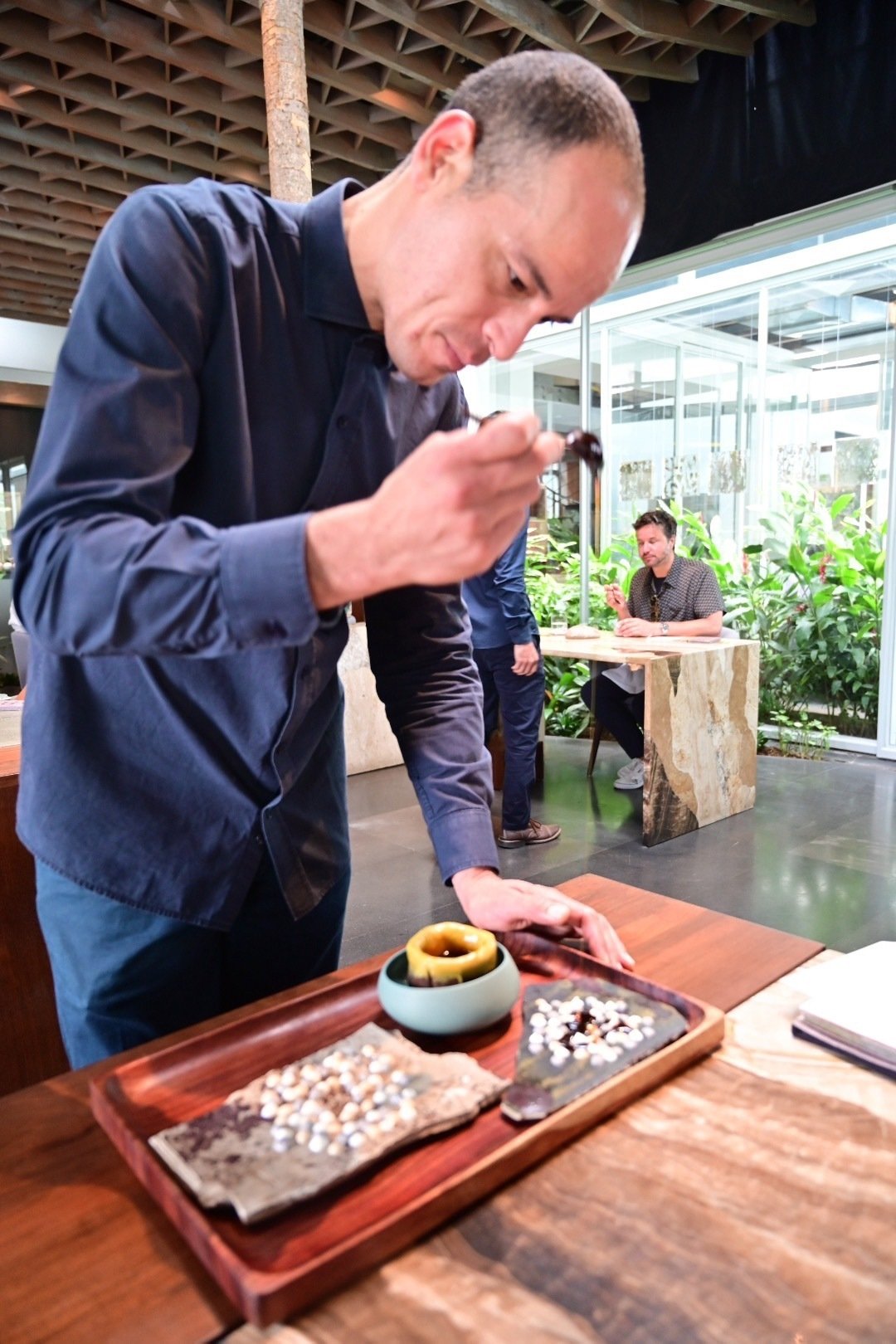
後で調べるとココナはトマトに似たフルーツで、生のままサラダに使うようだが、ここではそのフルーツを乾燥させ、すりおろした粉を使って焼いた蒸しパン状のものが出てきた。

もう一つの「空飛ぶジャガイモ」パーパ・ボラドーラは芋が土の中で育つのではなく、高い枝からぶら下がって成るため、こんな名前が付けられたそうだ。お皿の上にはその芋の粉を使った揚げドーナツというか、沖縄のサーターアンダーギーそっくりのものが乗っていた。
わかりやすくまとめると、未知の芋の粉を使ったサーターアンダギーと、フルーツの粉を使った蒸しパンを、メープルシロップのようなヤーコンの根のシロップをかけて食べる。全てが未知の食材だが、田舎らしい素朴な味わいがした。
料理名になっている高地熱帯雨林とはペルー中央部のシエラとセルバの境にあるルパ=ルパ地域を指すようだ。ここは標高が1000mを超える高地にも関わらず、植生は熱帯雨林で、ペルーで最も気温の高い地域となっているそう。

次なる3杯目は赤ワインとなった。ニュージーランド・マールボロのピノ・ノワール2018年産。チェリーやザクロのフルーティーなアロマとピノらしい淡い色合い。これは単純に美味い!

そんなピノ・ノワールを合わせる4皿目は「極端な高度:海抜4200m とうもろこし、キウィチャ(アマランサス)、さつまいもの葉」。
富士山よりも400m以上も高い海抜4200mの食材を使ったこちらは、日本の茶飲みのような器に入っていて、見た目はカラフルな茶碗蒸しのよう。アンデスには400種類以上ものとうもろこしが存在しているというが、器の底に沈む卵色のクリームはそんなアンデス産とうもろこしを数種類使ったもの。小豆色の小さな粒粒はキヌアに似たヒエ系の雑穀のキウィチャ。キウィチャはキヌア以上に栄養価が高いため、日本では英語のアマランサスという名前でスーパーフード扱いされている。その上のピンク色のチップスは乾燥させたさつまいも。緑色のチップスはさつまいもの葉っぱ。茶碗蒸しのようにスプーンで口に入れると、プチプチとカリカリとクリームのテクスチャーのせめぎあいの後、とうもろこしやさつまいものほんのりした甘さが残る。厳しい自然の食材だけに、厳しい自然の土地を好むブドウのピノ・ノワールと合せたのかもしれない。
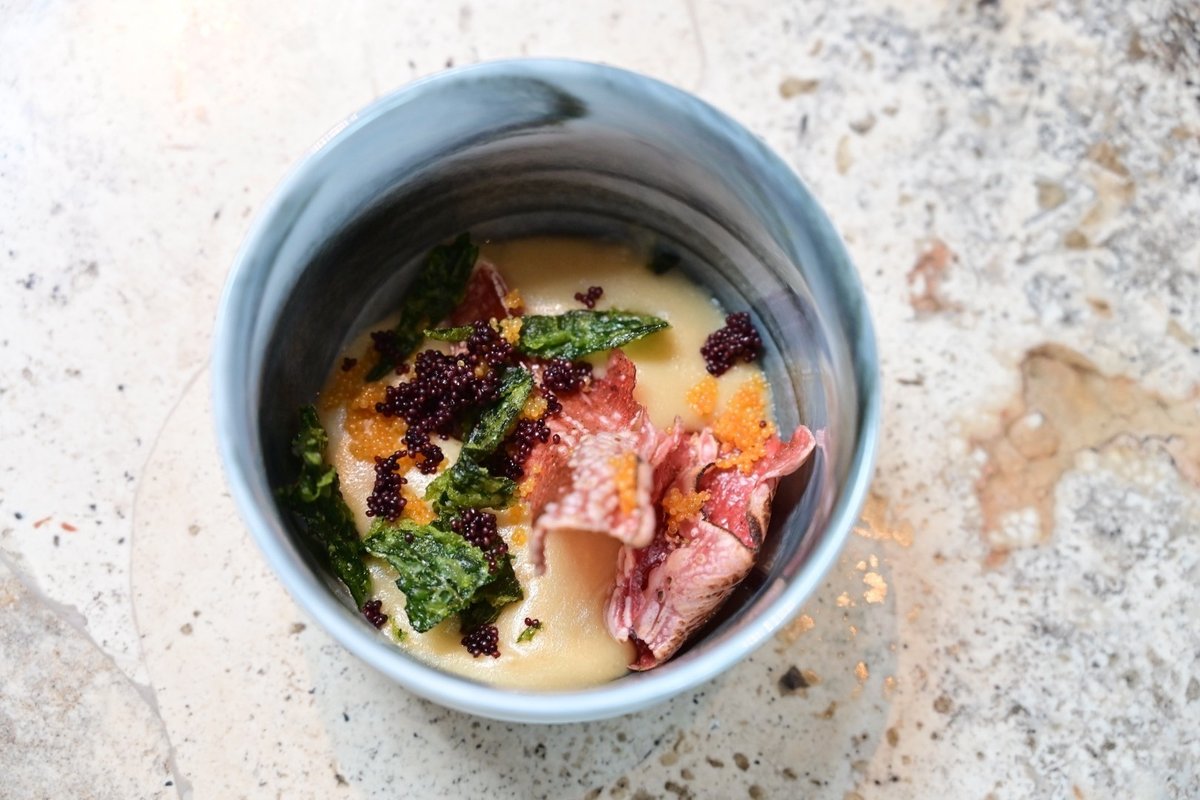
4杯目のワインは今度はオーストリア・ヴァッハウ地方のツヴァイゲルトとザンクト・ラウレントというぶどう品種を使ったロゼ。僕は近年、オーストリアやドイツ、ポーランドなど寒い国のワインを好んで飲んでいる。このロゼは初めていただいたが、寒い国ならではのキリっとした辛口ミネラルが良い!

辛口のロゼに合わせる5品目は「暖かい海流:海抜マイナス15m ハタ、マテ貝、二枚貝」。
益子焼きそっくりの分厚い小鉢に、ハタの身をすりつぶして揚げたかき揚げによく似たゴルフボール大の揚げ物、そして底には出汁が沈む。上に海藻で青緑に染めたマテ貝の身がのっている。和食そっくりのプレゼンテーションに箸を使って食べたくなる。周りはサクサクとして、内側ははんぺんのようにフワフワ。これはまるで上品なハタの真薯ではないか!
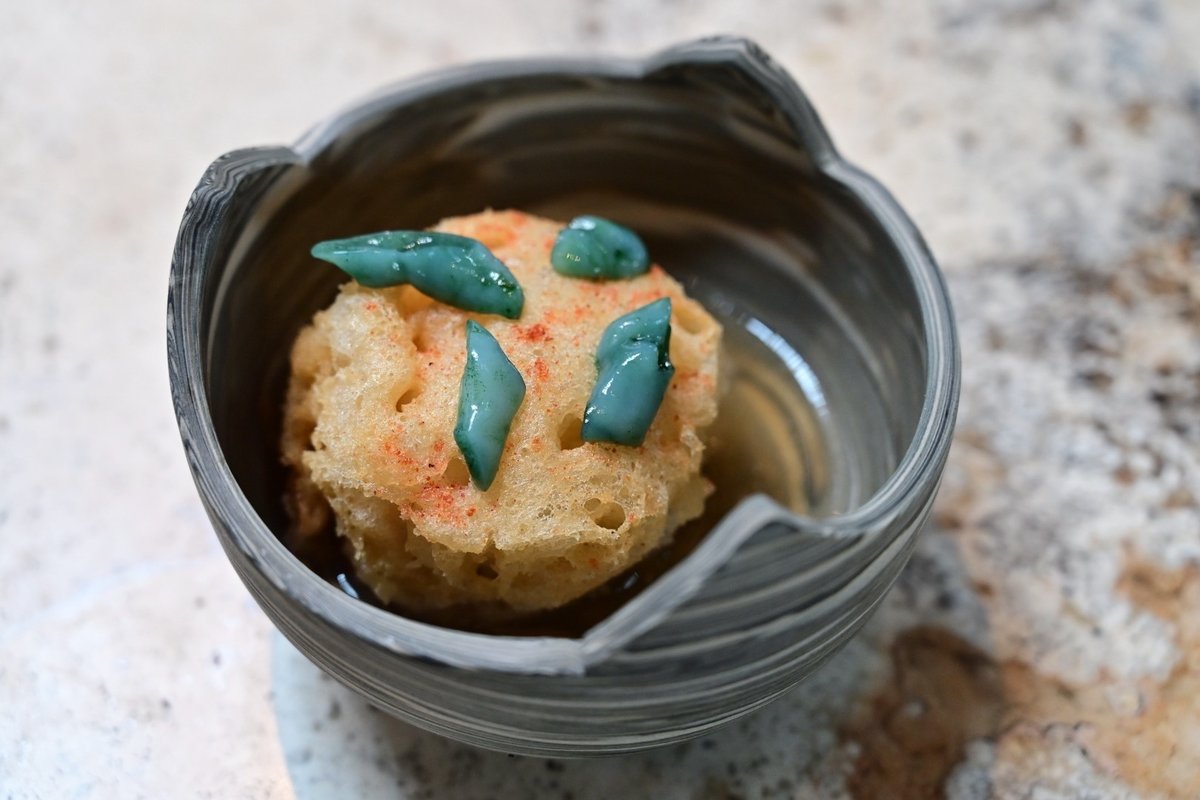
世界最大の淡水魚ピラルクの料理
「次はアマゾン最大の淡水魚、ピラルクを使った料理です」
そう言って、若いウェイターが長さ25cmほどの真紅の不気味な置物を運んできた。三枚に下ろしたピラルクのカマと胸鰭と上身を乾燥させて、防腐加工したものだった。防腐剤の色なのか、ボルドーの赤ワインのようなマルーン色に染まっていて、鱗が凶悪なほど大きい。ゲッ、こんな魚を食べるんですか?
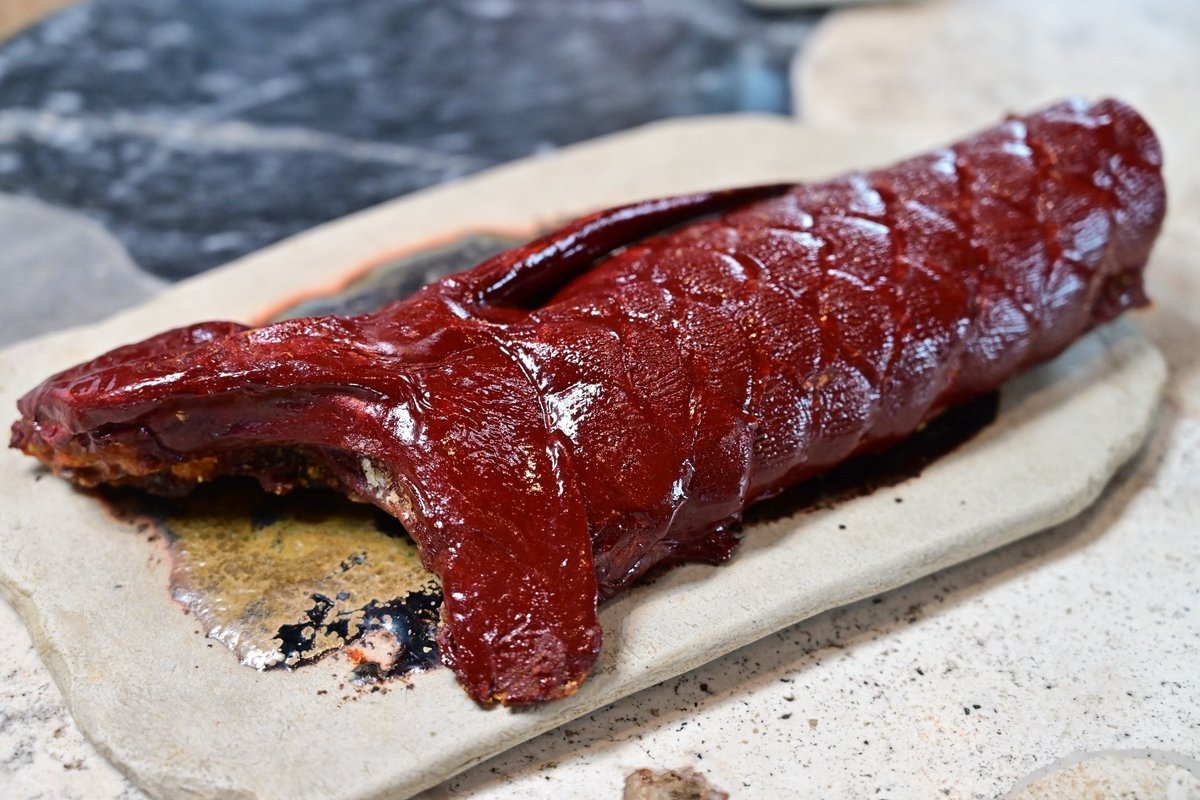
ピラルクは体長3m、体重200kgを超える世界最大の淡水魚。日本でも水族館などで観賞用に目にすることはあるが、アマゾンでは貴重なタンパク源とされている。今回のペルーでは翌日からアマゾン最大の都市イキトスを訪れるので、現地でピラルクのセビーチェやフライを食べるつもりでいた。それを一日繰り上がって、セントラルでも食べることになるとは!
凶悪なピラルクの半身を見せられ、心の準備が出来た後に運ばれてきた6品目、「アマゾンの繋がり:海抜148m Cecina(セシーナ)、ピラルク、キャッサバ」は拍子抜けするほどまともな見た目だった。やはり益子焼きそっくりの小さなお椀に入っていて、醤油や唐辛子で煮付けたピラルクの切り身を、セシーナというアマゾン産ベーコンで作ったオレンジ色の泡で覆ってある。ピラルクは全く癖がない白身の魚で、味は鱸(スズキ)によく似ている。セシーナについては二日後に訪れたアマゾンの街イキトスの生鮮市場にて、正確には豚のベーコンではなく、ほかの哺乳類の肉のベーコンだったことが判明するのだが、それはまだここでは触れずにおこう。とにかく、魚の旨みと薄味のベーコンの旨みが、これまたペルーならではの唐辛子の複雑な味と溶け合ったやさしい一品だ。

ここまで6品、ペルー海流からアマゾン熱帯雨林、砂漠の谷、アンデス山脈まで、4000mを超える標高差と異なった地勢がもたらすバリエーション豊かすぎる未知の食材を使ったマジカルな料理をジェットコースターのように味わってきた。母なる大地の旅はまだまだ続く。
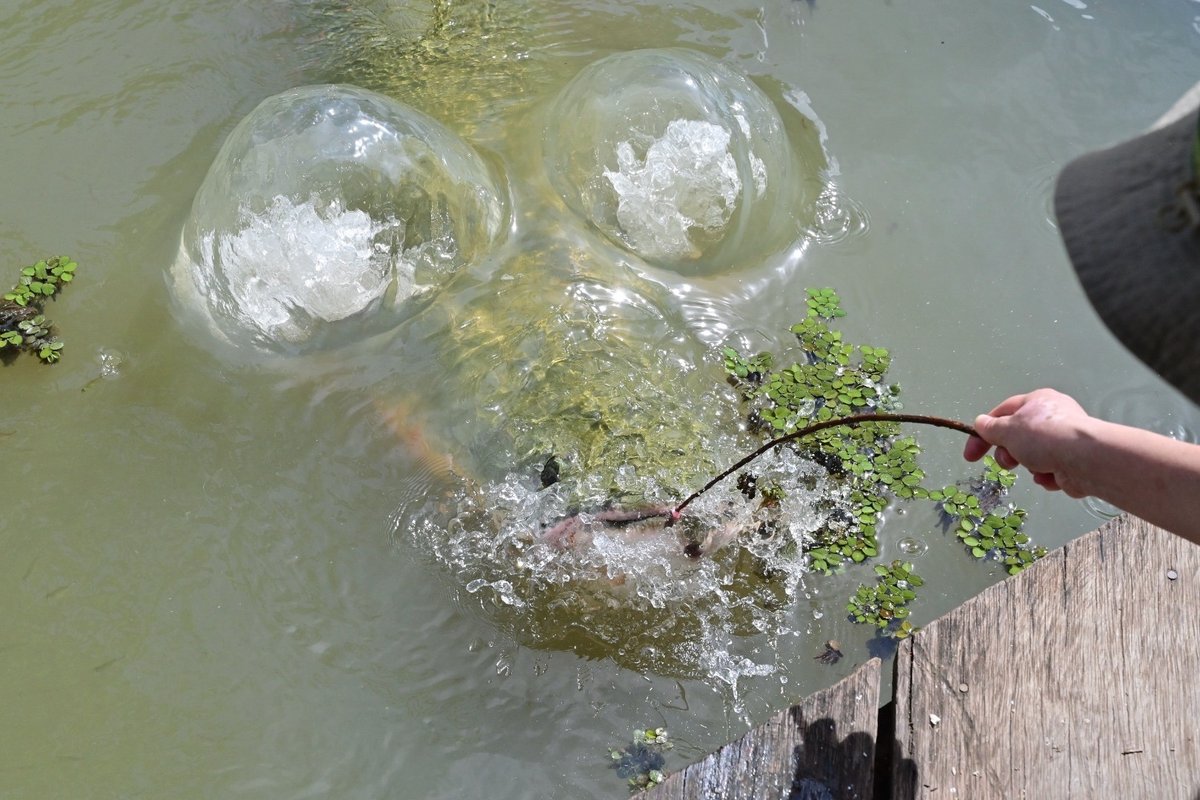
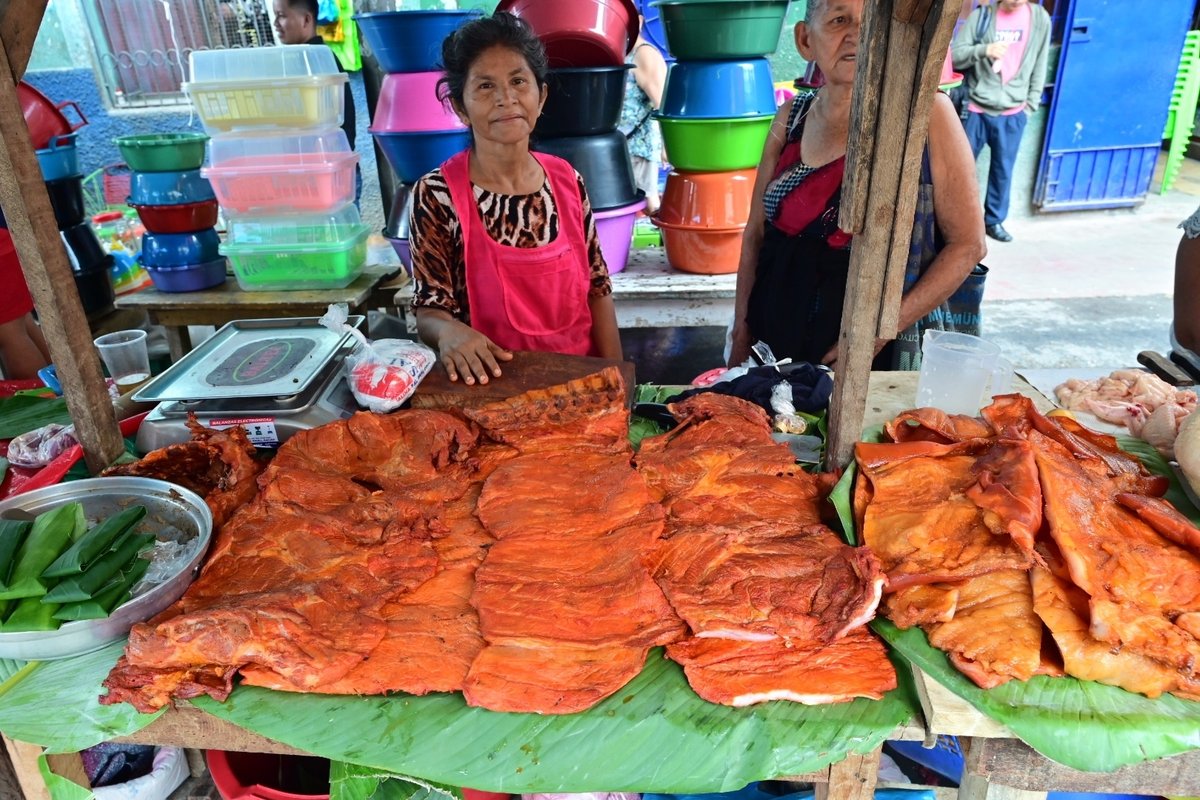
Title: Peru Edition 2: Central's "Mundo Matar" Menu
Since last summer, I've been continuously traveling and working in Okayama, Toyama, Seoul, Hungary, Spain's Galicia and Basque regions, Istanbul, Foshan in China, and Vietnam. Moreover, at the end of the year, my 11th book, "Marginal Foodie Tour," was published. Although there has been a six-month gap since my last post, I'm resuming my article series on the Lima, Peru-based restaurant 'CENTRAL,' currently considered the world’s finest, having been ranked No.1 by The World's 50 Best Restaurants.com in 2023. On February 14, 2023, I visited Central with Shankar Naguchi of the India-American Chamber of Commerce, curry chef Jinpei Mizuno, and Nobuyuki Yamanobori from the popular Indian restaurant 'Shiva Currywala' in Sancha. We opted for the expanded 14-course "Mundo Matar (Mother Earth)" menu, an evolution of their signature 12-course "Altitude Menu." For more details on our trip to Peru and the background, please refer to my previous article.
Pairing Drink: Global Wine Course
For the "Mundo Matar (Mother Earth)" menu, we chose from three pairing drink courses. The first was a Peruvian alcohol course combining local wines, the distilled grape spirit Pisco, and other local fermented drinks (454 Sol, roughly 15,890 yen at that time), the second was a course of carefully selected wines from around the world (424 Sol, about 14,840 yen), and the third was a non-alcoholic drink course (225 Sol, approximately 7,875 yen). As a wine lover, I naturally selected the global wine course. The first glass served was a biologically cultivated Blanc de Noirs champagne, made from Pinot Noir grapes, both delicious and uplifting.
The first amuse-bouche, "Black Stone: Sea Level minus 10m, Seaweed, Clams, Squid," consisted of three bite-sized items. The first was a dumpling topped with raw squid, likely made from dried squid powder and cornflour, served on an ancient stone slab. The striking teal color came from seaweed. Upon tasting, the rich and fresh flavors of squid and seaweed spread in the mouth.
The second was a cobalt blue cream in a matching bowl, also deriving its vivid blue from seaweed. It contained a cream of seaweed and clams, with a unique sourness unlike lemon or lime.
The third hid fresh Maté shellfish meat in a sea-flavored foam, again with a different kind of sourness, topped with green herb oil and possibly black seaweed oil. Delicious! The second and third, marinated seafood in acidity, could be considered variations of Peru's signature dish, ceviche. Interestingly, the squid, clams, and Maté shellfish all hailed from the Pacific's shallow waters at a sea level of minus 10 meters.
The second drink was a white wine from Spain's northern Rioja region, made from the Viura grape variety and a considerable vintage from 2011, offering a wonderful barrel aroma.
The accompanying second dish was "Dry Valley: Sea Level 55m, River Shrimp, Butternut Squash, Avocado." A hollowed-out small pumpkin is used as a container filled with greenish butternut squash cream, at the bottom of which lie lightly Amerique-sauced river shrimp and avocado, topped with dried pumpkin powder. The river shrimp, differing from the smaller Japanese variety, resembles the larger Japanese Akaza shrimp in size and richness of flavor. This dish illustrates the diversity of Peru's regions: the desert-like 'Costa,' the Andean 'Sierra,' and the Amazonian rainforest 'Selva.' Many rivers from the Sierra flow into the Costa along the Pacific coast, creating valleys that bring rich ecosystems to the otherwise dry land. The river shrimp, avocado, and butternut squash symbolize these "Dry Valleys."
The next course was "Highland Tropical Rainforest: Sea Level 1350m" featuring Cocona (a fruit), Papa Voladora (a type of potato), and Yacon root. The dish begins with the waiter finishing the sauce at the table. The main ingredients, Cocona and Papa Voladora, are presented on separate plates. The Cocona, a fruit native to the Amazon, is served as a dried and powdered form, used in a steamed bread-like dish. The Papa Voladora, known as 'flying potato' because it grows on high branches rather than underground, is served as a fried doughnut or similar to the Okinawan Sata Andagi. This combination of unknown tuber flour doughnut and fruit flour steamed bread is served with Yacon root syrup, reminiscent of maple syrup, offering a rustic and unfamiliar taste.
The name "Highland Tropical Rainforest" refers to the Lupa-Lupa region, a high-elevation area surrounded by tropical rainforest and known as one of the warmest regions in Peru.
Continuing the culinary journey, the third drink was a red wine, a 2018 Pinot Noir from Marlborough, New Zealand, with fruity aromas of cherry and pomegranate. The next dish, "Extreme Altitude: Sea Level 4200m," utilized corn, Kiwicha (Amaranth), and sweet potato leaves. This high-altitude dish, served in a bowl resembling a Japanese tea cup, looks like a colorful chawanmushi (Japanese steamed egg custard). The cream at the bottom is made from various types of Andean corn. The small reddish grains are Kiwicha, a high-nutritional grain related to quinoa, while the pink and green chips on top are dried sweet potato and sweet potato leaves, respectively. The interaction of textures – popping, crunchy, and creamy – is followed by a lingering sweetness of corn and sweet potato. The pairing with Pinot Noir, a grape that thrives in harsh natural conditions, might symbolize the ruggedness of the ingredients’ origins.
The fourth wine was a Rosé from Austria's Wachau region, made from Zweigelt and Sankt Laurent grape varieties. This Rosé, my first taste of it, highlighted the crisp, dry minerality characteristic of wines from colder regions.
Paired with the dry Rosé, the fifth dish was "Warm Current: Sea Level minus 15m," featuring Grouper, Maté shellfish, and bivalves. Served in a thick, Mashiko-yaki-like small bowl, was a golf ball-sized fried item resembling tempura, made from mashed Grouper meat, with a base of broth. Atop it sat seaweed-dyed green Maté shellfish meat. The presentation, reminiscent of Japanese cuisine, made one want to eat it with chopsticks. The outer layer was crispy, while the inside was fluffy like Hanpen, a Japanese fish cake, epitomizing the delicate taste of Grouper.
World's Largest Freshwater Fish Pirarucu Dish
The next dish featured the Amazon's largest freshwater fish, Pirarucu. A young waiter brought a menacing, 25 cm long crimson ornament, which turned out to be a dried and preserved half of a Pirarucu, including the gill cover, pectoral fin, and upper body. Tinged in a maroon color reminiscent of Bordeaux red wine, possibly due to the preservative, the scales were intimidatingly large. The thought of eating such a fish was initially shocking.
Pirarucu, reaching over 3 meters in length and weighing more than 200 kg, is the world's largest freshwater fish. Although it's commonly seen in aquariums in Japan, it's a valuable protein source in the Amazon. I had planned to try Pirarucu ceviche and fried dishes in Iquitos, the largest city in the Amazon, the following day. However, the chance to taste it at Central came a day earlier.
After being mentally prepared by seeing the imposing half of the Pirarucu, the sixth dish, "Amazon Connection: Sea Level 148
m 148m, featured Cecina (a type of Amazonian bacon), Pirarucu, and cassava. Surprisingly, the dish had a more conventional appearance than expected, served in a small bowl resembling Mashiko-yaki pottery. It contained a piece of soy sauce and chili-simmered Pirarucu covered with an orange foam made from Cecina. The Pirarucu, a white-fleshed fish with no distinctive taste, resembled European sea bass (Suzuki) in flavor. The combination of the fish's savoriness and the mild bacon, enriched with the complex chili flavor typical of Peru, resulted in a gentle and harmonious dish.
Up to this point, six dishes had been served, spanning from the Peruvian sea currents to the Amazon rainforest, the desert valleys, and the Andean mountains, a journey through a 4000m altitude variation showcasing Peru's diverse and magical ingredients. The culinary journey through "Mundo Mater(Mother Earth)" continues.
この記事が気に入ったらサポートをしてみませんか?
